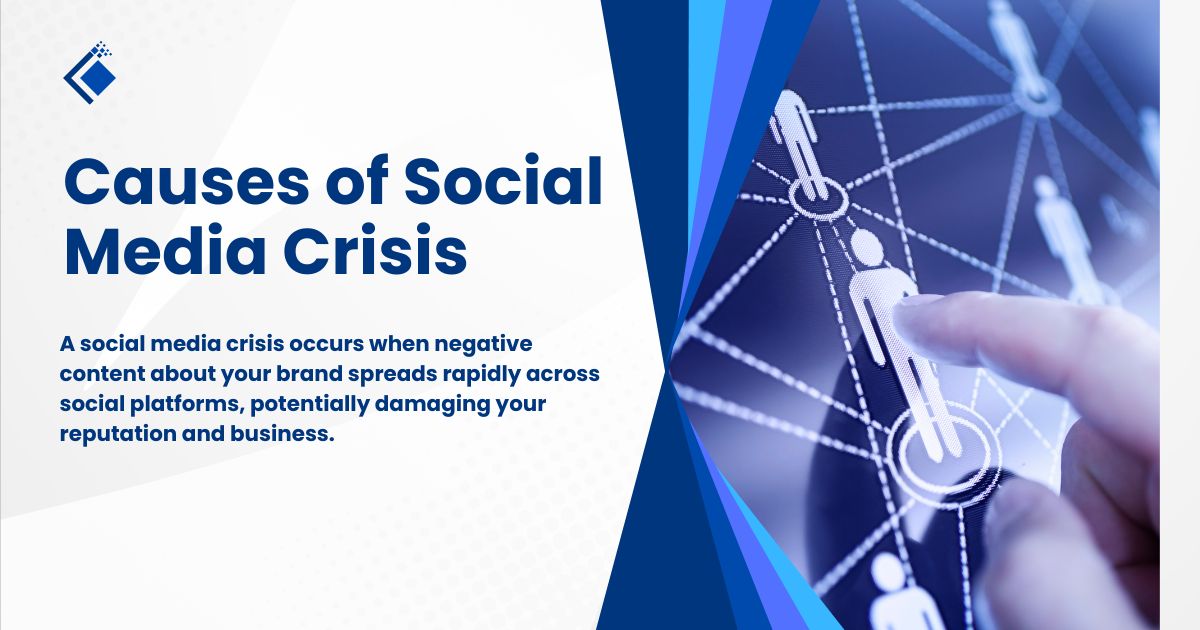
One poorly timed tweet. A single insensitive post. An employee’s personal opinion shared on the company account. Any of these scenarios can spiral into a full-blown social media crisis within hours, leaving brands scrambling to contain the damage.
Social media crises don’t discriminate—they’ve affected everyone from Fortune 500 companies to small local businesses. The speed at which information spreads across platforms means that what starts as a minor misstep can quickly become a reputation-threatening disaster.
This post explores the seven most common triggers of social media crises and provides actionable strategies to help you avoid them. By understanding these pitfalls, you’ll be better equipped to protect your brand’s reputation and maintain customer trust.
What Makes a Social Media Crisis?
A social media crisis occurs when negative content about your brand spreads rapidly across social platforms, potentially damaging your reputation and business. Unlike traditional PR issues, social media crises move at lightning speed and can reach millions of people within hours.
The key characteristics of a social media crisis include:
- Rapid spread of negative content
- High volume of negative comments or mentions
- Mainstream media pickup
- Potential impact on sales or business operations
- Damage to brand reputation and customer trust
The 7 Most Common Causes of Social Media Crisis
1. Insensitive or Offensive Content
Perhaps the most explosive type of social media crisis stems from content that audiences find offensive, insensitive, or tone-deaf. This includes posts that are racist, sexist, homophobic, or culturally insensitive.
These crises often occur when brands:
- Fail to consider cultural context
- Use humor inappropriately
- Post content without proper review
- Ignore current events or social climate
Prevention strategies:
- Implement a content approval process
- Educate your team on cultural sensitivity
- Monitor current events and social conversations
- Create content guidelines that outline what’s acceptable
2. Employee Misconduct on Social Media
When employees share inappropriate content or make controversial statements on their personal accounts while identifying as company representatives, it can reflect poorly on your brand. Even worse is when employees accidentally post personal content on company accounts.
Common scenarios include:
- Personal political opinions shared on company accounts
- Inappropriate jokes or comments
- Confidential company information leaked
- Employees engaging in online arguments
Prevention strategies:
- Develop clear social media policies for employees
- Provide regular training on appropriate online behavior
- Use social media management tools with user permissions
- Create separate personal and professional account guidelines
3. Poor Crisis Response
Sometimes the initial issue isn’t the main problem—it’s how a company responds to criticism that turns a small incident into a major crisis. Poor crisis management can include defensive responses, ignoring the issue, or making the situation worse with inappropriate follow-up communications.
Signs of poor crisis response:
- Deleting negative comments without addressing concerns
- Responding defensively or aggressively
- Ignoring the issue hoping it will disappear
- Making excuses instead of taking responsibility
Prevention strategies:
- Develop a crisis response plan before you need it
- Train your team on appropriate response protocols
- Respond quickly and transparently
- Take responsibility when appropriate
4. Customer Service Failures

Social media has become a primary channel for customer complaints. When businesses fail to respond appropriately to customer issues or when private customer service failures become public, they can quickly escalate into broader crises.
Common customer service triggers:
- Ignoring customer complaints
- Providing inadequate solutions
- Being rude or dismissive
- Failing to follow up on promised resolutions
Prevention strategies:
- Monitor social media mentions consistently
- Respond to complaints promptly and professionally
- Train customer service teams on social media best practices
- Move complex issues to private channels when appropriate
5. Technical Errors and Automation Failures
Automated posts, scheduled content, and technical glitches can lead to embarrassing situations. These might include posting pre-scheduled celebratory content during a tragedy or having automated responses that seem inappropriate given current events.
Examples of technical failures:
- Scheduled posts going live during inappropriate times
- Automated responses to sensitive topics
- Cross-posting errors between platforms
- Bot malfunctions creating spam-like behavior
Prevention strategies:
- Regularly review and update scheduled content
- Monitor automated systems closely
- Have manual override capabilities
- Test automation tools thoroughly before implementation
6. Influencer and Partnership Issues
When influencers or business partners associated with your brand face controversies, it can negatively impact your reputation by association. This type of crisis can be particularly challenging because it’s often outside your direct control.
Partnership-related risks include:
- Influencer scandals or inappropriate behavior
- Partner company controversies
- Sponsored content that doesn’t align with brand values
- Affiliate misconduct
Prevention strategies:
- Thoroughly vet partners and influencers
- Include morality clauses in contracts
- Monitor partner activities regularly
- Have exit strategies for problematic partnerships
7. Product or Service Failures
When your product or service fails, customers often turn to social media to voice their frustrations. If these issues aren’t addressed properly, they can snowball into larger reputation problems.
Product-related crisis triggers:
- Safety issues or product recalls
- Service outages or technical problems
- Quality control failures
- Misleading marketing claims
Prevention strategies:
- Maintain high quality standards
- Communicate proactively about known issues
- Provide clear channels for reporting problems
- Address product concerns quickly and transparently
Building Your Crisis Prevention Strategy
Create a Social Media Policy
Develop comprehensive guidelines that cover:
- Acceptable content types and topics
- Approval processes for sensitive content
- Employee personal account guidelines
- Crisis response protocols
Implement Monitoring Systems
Use social media monitoring tools to:
- Track brand mentions across platforms
- Identify potential issues early
- Monitor competitor crises for learning opportunities
- Set up alerts for unusual activity spikes
Prepare Response Templates
Having pre-approved response templates for common scenarios can help you respond quickly and appropriately. Create templates for:
- Acknowledging customer complaints
- Addressing misinformation
- Responding to technical issues
- Communicating during crises
Train Your Team
Regular training should cover:
- Social media best practices
- Crisis identification and escalation
- Appropriate response techniques
- Cultural sensitivity awareness
What is Social Media Crisis Management Software?
Social media crisis management software is designed to help businesses address potential threats or crises on social platforms. These tools automate monitoring, analyze sentiment, and provide actionable insights to detect and respond to problems before they spiral out of control.
From real-time alerts to in-depth analytics, crisis management tools empower brands to act swiftly, maintain transparency, and protect their reputation during challenging moments.
Why is Crisis Management Software Essential for Your Brand?
Crises move fast. You need to move faster. Social media crisis management software offers several key benefits to businesses of all sizes:
- Early Detection: With 24/7 monitoring and sentiment analysis, issues are flagged before they escalate.
- Efficient Communication: Manage and streamline your team’s responses to create cohesive messaging during stressful situations.
- Reputation Protection: By responding promptly and effectively, you minimize harm to your brand image.
- Insights and Learning: Post-crisis analytics help you identify pitfalls and improve future strategies.
Without the right tools, it’s nearly impossible to effectively monitor online conversations across multiple platforms, let alone engage in meaningful, real-time responses.
Protecting Your Brand’s Future

Social media crises are often preventable with the right strategies and awareness. By understanding these common triggers and implementing proactive measures, you can significantly reduce your risk of facing a reputation-damaging incident.
Remember that crisis prevention is an ongoing process, not a one-time effort. Regular training, policy updates, and monitoring are essential components of a robust social media risk management strategy.
Start by auditing your current social media practices against these common crisis causes. Identify your vulnerabilities and develop action plans to address them before they become problems. Your brand’s reputation depends on the preparation you do today.



















No Comments